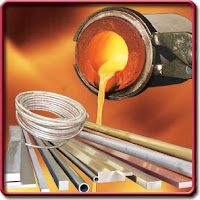 Also known as porous plugs, gas diffusers have been used for many years in ladles to enable gas purging of steel melts before streaming the metal into molds. The purging process degasses the melt and makes cleaner steel that results in a repressed scrap rate in castings.
Also known as porous plugs, gas diffusers have been used for many years in ladles to enable gas purging of steel melts before streaming the metal into molds. The purging process degasses the melt and makes cleaner steel that results in a repressed scrap rate in castings.According to experts, the proper use of gas diffusers provides a variety of benefits in induction melting. These include reduced scrap rates, more efficient melt, and a considerable improvement in furnace operational life.
For safe and effective functioning of a gas diffuser, several factors have to be taken into account. The chosen refractory material should be able to withstand penetration when in touch with liquid metals. The gas diffuser should be designed in a way so that it supplies little quantities of inert gas to the induction furnace melt in a controlled manner. The diffuser must also be compatible with the lining materials of the induction furnace. The diffuser must also be designed in a way so as to ensure easy installation, operation and long service life.
If possible, the diffuser must be fitted in the center of furnace base, or as close as possible to the center.
The furnace should have a gas supply to connect to the gas diffuser, and a there should be a proper gas-flow control arrangement. Such a system can be as simple as a pressure regulator on an argon-gas bottle with an inlet needle valve and flow meter; or as complex as a PLC package linked to a computer-controlled process control arrangement.
The induction furnace lining should be sintered before using the gas diffuser; this helps the gas to pass through the lining without disturbing it. In order to ensure proper sintering, gas diffusers should not be used early in the melting process. According to experts, best results can be obtained by bringing in the gas to the diffuser during the 3rd melt and onward.